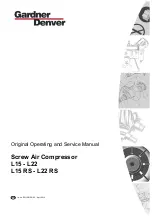
Do not at any time let brake fluids,
gasoline, petroleum-based
products, penetrating oils, etc.,
come in contact with plastic parts.
Chemicals can damage, weaken,
or destroy plastic which may result
in serious personal injury. Electric
tools used on fiberglass material,
wallboard, spackling compounds,
or plaster are subject to accelerat-
ed wear and possible premature
failure because the fiberglass chips
and grindings are highly abrasive
to bearings, brushes, commuta-
tors, etc. Consequently, we do not
recommend using this tool for
extended work on these types of
materials. However, if you do work
with any of these materials, it is
extremely important to clean the
tool using compressed air.
Drain the air tank of moisture after
operation.
When not in use, store the
compressor in a cool, dry place.
Disconnect the air hose and hang
open ends down to allow any
moisture to drain.
Protect the electrical cord and air
hose from damage (such as being
stepped on or run over). Wind them
loosely around the compressor
handle.
1.
2.
4.
3.
CARE AND CLEANING
GENERAL MAINTENANCE
(CONTINUED)
Inspect the tank annually for rust,
pin holes, or other imperfections
that could cause it to become
unsafe.
3.
Avoid using solvents when cleaning
plastic parts.
4.
Most plastics are susceptible to
damage from various types of
commercial solvents and may be
damaged by their use.
5.
Use clean cloths to remove dirt,
dust, oil, grease, etc.
6.
Any service, other than general
maintenance, should be performed
by an authorized service represen-
tative.
7.
TROUBLESHOOTING
PROBLEM
The Compressor
does not run.
POSSIBLE CAUSE
CORRECTIVE ACTION
There is a loss of power or
the motor is overheated.
Check for proper use
of extension cord.
Check to be sure the
unit is plugged in.
Check the
fuse/breaker.
Turn the air compres-
sor OFF. Unplug air
compressor and wait
until compressor
cools down.
Plug the air compres-
sor into an approved
outlet.
Turn the air
compressor ON.
There is no power to the
unit.
The circuit breaker has
tripped or a fuse has
blown at the main power
source.
The thermal overload
protector is actuated.
12
13
WARNING:
Always release all pressure,
disconnect from power supply, and
allow unit to cool to the touch before
cleaning or making repairs on the air
compressor.
WARNING:
MODEL: S3GCOMP
MODEL: S3GCOMP


























